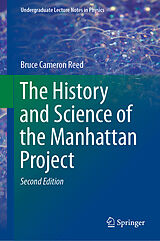The History and Science of the Manhattan Project
Einband:
Fester Einband
EAN:
9783662581742
Untertitel:
Undergraduate Lecture Notes in Physics
Autor:
Bruce Cameron Reed
Herausgeber:
Springer Berlin Heidelberg
Auflage:
2nd ed. 2019
Anzahl Seiten:
556
Erscheinungsdatum:
01.03.2019
ISBN:
3662581744
In this book, a physicist and expert on the history of the Manhattan Project clearly explains the underlying science behind the development of the atomic bomb, including how atomic bombs work, the Hiroshima and Nagasaki missions, and the legacy of the Project.
The development of atomic bombs under the auspices of the U.S. Army's Manhattan Project during World War II is considered to be the outstanding news story of the twentieth century. In this book, a physicist and expert on the history of the Project presents a comprehensive overview of this momentous achievement. The first three chapters cover the history of nuclear physics from the discovery of radioactivity to the discovery of fission, and would be ideal for instructors of a sophomore-level Modern Physics course. Student-level exercises at the ends of the chapters are accompanied by answers. Chapter 7 covers the physics of first-generation fission weapons at a similar level, again accompanied by exercises and answers. For the interested layman and for non-science students and instructors, the book includes extensive qualitative material on the history, organization, implementation, and results of the Manhattan Project and the Hiroshima and Nagasaki bombing missions. The reader also learns about the legacy of the Project as reflected in the current world stockpiles of nuclear weapons. This second edition contains important revisions and additions, including a new chapter on the German atomic bomb program and new sections on British and Canadian contributions to the Manhattan project and on feed materials. Several other sections have been expanded; reader feedback has been helpful in introducing minor corrections and improved explanations; and, last but not least, the second edition includes a detailed index.
This is the only introductory-level history of the Project prepared by a writer who is a physicist and who has broad knowledge of the relevant scientific details Ideal for readers who have no specialized physics background but who want to learn more about how atomic bombs came to be Provides a deeper understanding of some of the technical issues involved in developing atomic bombs for those readers who possess high-school physics knowledge An ideal text for a college-level general education history or science class Based on years of research by the author into the physics of nuclear weapons, augmented by familiarity with relevant official archival documentation Second edition significantly extended and enhanced
Autorentext
The author holds a Ph.D. in Physics from the University of Waterloo (Canada) and has published over 30 technical and semi-popular-level papers on the Manhattan Project and related nuclear history in publications such as American Journal of Physics, The Physics Teacher, European Journal of Physics, Natural Science, American Scientist, Physics & Society and Physics in Perspective. In 2009 he was made a Fellow of the American Physical Society in recognition of his contributions to the history of both the physics and the development of nuclear weapons in the Manhattan Project.
Inhalt
Introduction and Overview.- A Short History of Nuclear Physics to the Mid-1930s.- The Discovery and Interpretation of Nuclear Fission.- Organizing the Manhattan Project, 1939-1943.- Oak Ridge, CP-1, and the Clinton Engineer Works.- The Hanford Engineer Works.- Los Alamos, Trinity , and Tinian.- Hiroshima and Nagasaki.- The German Nuclear Program.- The Legacy of Manhattan.- Glossary.- Index.

Leider konnten wir für diesen Artikel keine Preise ermitteln ...
billigbuch.ch sucht jetzt für Sie die besten Angebote ...
Die aktuellen Verkaufspreise von 6 Onlineshops werden in Realtime abgefragt.
Sie können das gewünschte Produkt anschliessend direkt beim Anbieter Ihrer Wahl bestellen.
Loading...
Die aktuellen Verkaufspreise von 6 Onlineshops werden in Realtime abgefragt.
Sie können das gewünschte Produkt anschliessend direkt beim Anbieter Ihrer Wahl bestellen.
| # | Onlineshop | Preis CHF | Versand CHF | Total CHF | ||
|---|---|---|---|---|---|---|
| 1 | Seller | 0.00 | 0.00 | 0.00 |
